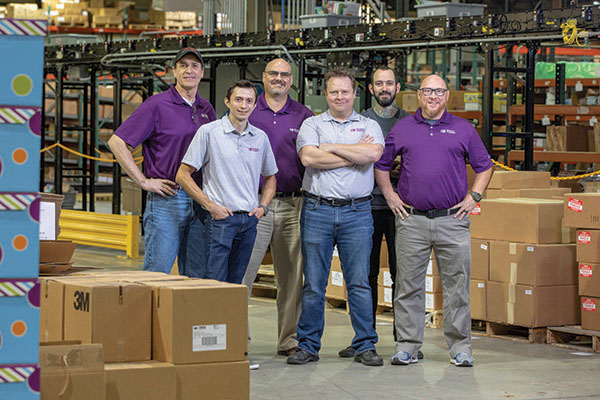In Tulsa, Educational Development Corp.’s new, automated distribution center is the result of decisions made in the past and the present—and sets the stage for tomorrow’s growth. This change first took place more than 30 years ago in 1986, when Randall White was promoted to chief executive officer. “We were a $6 million company with just 24 employees, and we’d lost $5 million in the previous five years,” White recalls. “I said then that we had a new rule that we’d spend less than we make. We haven’t had a losing quarter since.” As White recalls it, to keep the company going, and to take it public, he had to mortgage his house.
Fast forward to 2015, and White found himself in a similar situation when he was asked to provide a personal guarantee for a loan to purchase the 400,000-square-foot building that now houses 150,000 square feet of distribution space for EDC. “After 35 years, I’d come full circle,” says White. “Both times I did it because I believed in the business.”
That second decision—the one that will influence EDC’s supply chain of tomorrow—was made to accommodate explosive growth following what many might consider a counter-intuitive move. In 2012, EDC, a publisher and distributor of children’s books, decided to stop selling through Amazon, which then accounted for about 30% of one division’s business. Instead, the company hired a new sales manager and began to concentrate all its energy on a wholesale channel that sells books to stores like Barnes & Noble and a direct-marketing sales channel sold through independent consultants. Over the next few years, the number of active consultants grew from 7,000 to more than 30,000. During that same period, the distribution model changed from shipping mixed cases to consultants, to shipping small orders directly to the consultants’ customers. Since then, sales have grown from $35 million to an estimated $112 million.
Short of storage space, manpower and technology, EDC’s old 110,000-square-foot DC was ill-equipped to handle the growth in direct-to-customer orders. “Our order profile went from one $500 book order shipped to a consultant to distribute to 10 $50 book orders shipped directly to customers,” says Craig White, the company’s chief operating officer. “During the 2015 holiday season, we were working three shifts to ship out 5,000 orders a day and still couldn’t keep up with demand. We consistently had a 40,000-order backlog and our error rate was climbing.”
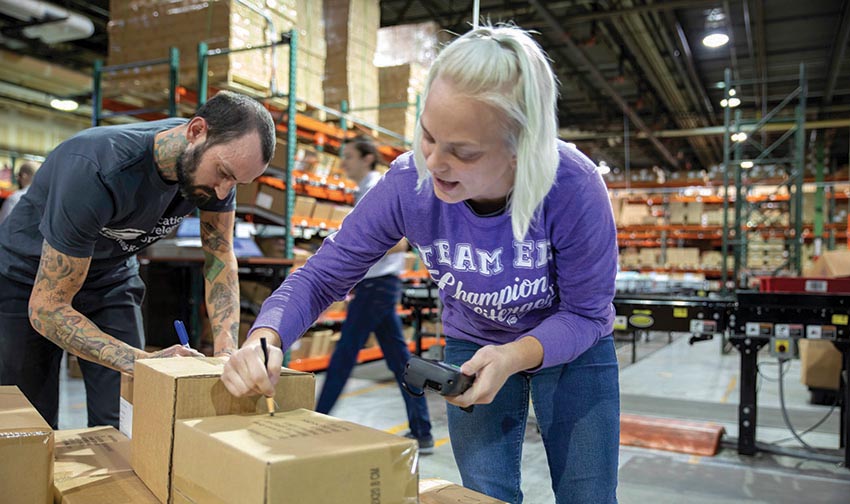
Books are prepared for storage in the receiving area and then delivered to a storage location.
The solution was a new 150,000-square-foot space. Working with two consultants (UPS and Cisco-Eagle), EDC implemented a warehouse management system (WMS), light-directed picking, three pick modules tied together by conveyor, a shipping sorter and an automated packaging line for one segment of orders. The result: As of this past June, labor costs were down 20% from the previous year while sales were up 10% for the same period.
What’s more, EDC is filling more orders in one shift than it used to fill across three shifts, and error rates have been significantly reduced. “Where we used to struggle to fill 5,000 orders across three shifts, last fall we did 10,000 orders in a nine-hour shift on three occasions, and 15,000 orders across two shifts.”
Or, as CEO Randall White puts it: “Today, the warehouse is the finest point of our operation.”
A future in books
Once recognized by Forbes as one of the 200 Best Small Companies in America, Educational Development Corp. was founded in 1965 to develop curriculum materials for schools. The Publishing Division was created in 1978 to distribute educational books for children in North America from the U.K. publisher Usborne Books. A Home Business Division was launched in 1989, using a multi-level marketing model much like Avon or Tupperware. In 2008, EDC acquired Kane Miller, a California-based publisher of children’s fiction and chapter and picture books. Titles like “Anna Hibiscus #1,” a Boston Globe Horn Book Honor title, have won numerous awards.
Between 1986, when Randall White became CEO, and 2012, when the company stopped selling to Amazon, sales plateaued at roughly $35 million. The decision that year to stop selling through Amazon made the front page of The New York Times business section and probably seemed suicidal to most book sellers.
White says it was a no-brainer. His wholesale customers didn’t like sales through Amazon, and customers of the direct-marketing division would scan the bar codes of titles at a home party and then buy the titles at a discount online. “At the time, it was a shock to the industry, but I believed we had a great sales force,” he says, adding “people roll their eyes when we mention direct selling, but our books are sold at the same price in book stores as the direct sales channel.” The company made up the lost Amazon revenue in one year, according to White.
A big driver of growth came from a new approach to selling discovered by the direct sales consultants: the Facebook party. Instead of hosting a physical party at someone’s home, starting around 2015, consultants began to host social media Facebook parties.
And, instead of shipping bulk orders to consultants, who then redistributed them to their customers, EDC began to ship the individual customer orders. At the end of the 2016 fiscal year, sales hit $65 million; at the end of the 2017 fiscal year, they were $105 million.
The additional sales also meant additional handling and freight. And, it all occurred during a period of business expansion following the acquisition of Kane Miller, which resulted in more inventory. The whole supply chain was stressed.
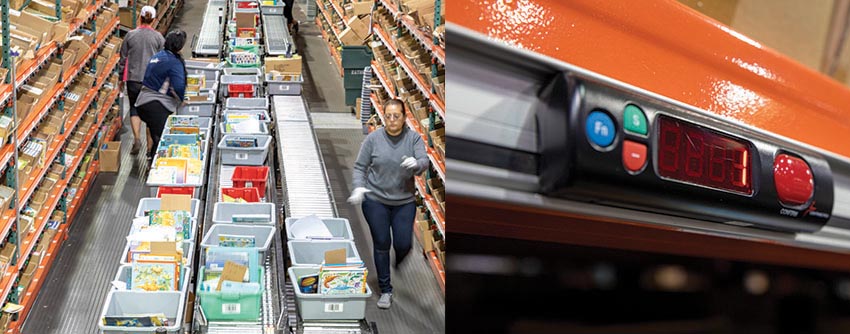
The new facility includes two pick modules that are mirrors of one another (left). Picking is directed by lights (right).
At the time of the Amazon decision, distribution was taking place in the company’s original 110,000-square-foot DC. As EDC geared up for the 2014 holiday season, it was getting five to 10 containers of books a week from China and needed an additional 40,000 square feet of space. “We were putting things wherever we could find room, picking from pallets on the floor and using temporary movable storage outside the building,” says COO Craig White. To try to keep up with orders, operations expanded from one to three shifts in short order, with little time for training new employees. Errors were frequent, and the company was losing an estimated $500,000 a year on freight. “We had to have an efficient system, and we had to introduce cost savings through technology so the business model could be profitable,” adds CEO White. Both men say it took a little more than two years to right the ship.
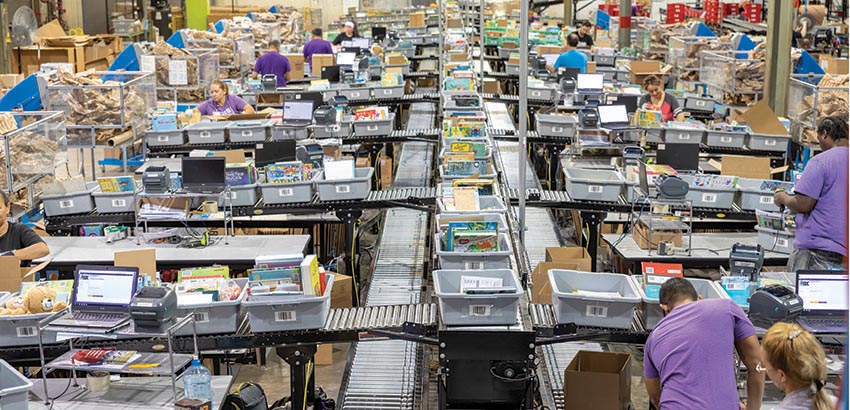
Orders are picked to totes that are then transported to the packing area, where they are prepared for shipping.
Finding space
The evolution took place in several steps. The goals, according to Craig White, were simple: Create more storage, get more orders out the door and streamline replenishment. “Our receiving process was smooth, despite having no place to put things and in packing, our biggest problem was getting enough people, not our processes,” he says.
The old building basically had a quarter-mile-long pick line. Totes were pushed on a gravity conveyor from pick zone to pick zone, and then traveled by powered conveyor to packing. Replenishment was with a Kanban system—cartons in the pick zone had tags with bar codes. When a box was empty, an associate put the tag in the box and empties were collected several times a day, which was the way the replenishment team was notified to replenish inventory. Orders often had to be picked complete in packing.
The first of those steps was the decision in the summer of 2015 to purchase a new building. The EDC team found a great 400,000-square-foot office and distribution space for sale by a manufacturer and distributor of power tools.
At first glance, it was too big and too expensive for EDC until the company learned that the manufacturer wanted to lease back 187,000 square feet for 15 years. That gave EDC the space it needed for warehousing and offices while the lease payments from the former owner covered the finance costs. The old tenant even left behind storage rack that could be repurposed.
The next step was to design a useful space that could meet those goals.
Design for efficiency
Given its position as one of the largest shippers in Oklahoma, EDC has developed a close relationship with UPS over the years. As the book seller began taking stock of the new space, UPS’s professional services group began making regular trips to the facility to offer suggestions.
As an example, before the move, they evaluated EDC’s existing processes using time and motion studies. “We learned that we were following best practices from a manual standpoint, such as using the right kind of boxes and void fill in packaging,” COO Craig White remembers. “So, they offered suggestions like putting in a carton erector and automatic box sealers in the new building, which we adopted right away.”
UPS also recommended the WMS system that EDC implemented in the new facility. The book distributor was already working with Cisco-Eagle in its old building and brought them in to design the facility layout. During that time, the pick-to-light vendor was added to the mix.
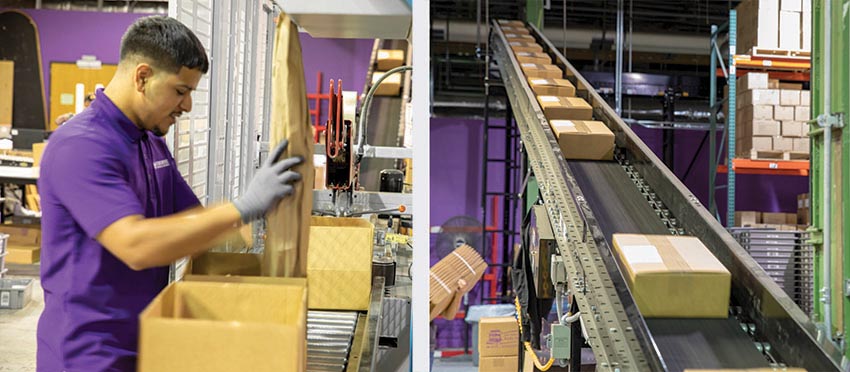
Dunnage is added to protect orders during transportation(left). Packages are then automatically sealed and conveyed to shipping.(right)
EDC moved into the new facility in February 2016, and the WMS and pick-to-light systems went live that spring. In this initial stage, there were significant physical changes. For instance, reserve storage was created by grouping three of the 36-inch deep narrow-aisle storage left behind by the former tenant into back-to-back racks to handle two 48-inch long pallets with access from the front and rear of the rack. That addressed some of the storage concerns.
The new facility included three pick lines instead of a single one. One was reserved for orders that could be filled from just the fastest moving SKUs. Initially, orders were picked, packed and palletized in that area, and then the pallet was delivered to shipping. The other two zones are mirror images of one another, with 14 pick zones on each line.
But, while the WMS and light-directed picking were added to the mix, the process was still pretty manual. An order was introduced at the beginning of the line and pushed on a gravity conveyor. An associate would scan the label on the carton, and lights would indicate what items needed to be picked in that zone. The carton was then pushed to the next zone. It was still very manual, but EDC did pick up some efficiencies.
Still, the 2016 holiday season was rough sledding, with 125,000 open orders going into December 2016 and a 5% to 7% error rate. “There were a lot of Christmases in January,” White says.
The next phase made all the difference. For one, UPS recommended the use of the powered conveyor down the middle of the pick zone to speed the movement of orders. This necessitated the addition of diverts so that an order only went to a pick zone if there were items to be picked. “Before, every picker touched every order,” says Craig White. “With diverts, they only touch the order if there is a pick in their zone.” “It used to take three hours to get an order through picking to packing and now it was roughly an hour,” says White.
Jimmy Cleveland, an experienced distribution manager at EDC, developed process improvements, such as the removal of steps, reaches and unnecessary materials, that delivered further efficiency gains. Work areas and surfaces were standardized with easy-to-reach tools and templates. Productivity gains were also achieved through process standardization and the implementation of performance metrics and expectations.
EDC began to manage performance through monitoring, reporting and coaching. “We had just implemented a dashboard that displayed key warehouse production indicators and displayed it on monitors throughout the warehouse along with the communicated expectations,” says White.
He adds that Saul Cornejo, one of the warehouse supervisors, stabilized the previously volatile workforce which was instrumental in being able to set process standards. Other supervisors brought stability to software, purchasing and inventory receipt and movement respectively. “It should not go unnoticed that a very good, dedicated management team working for myself and Jimmy made all of the transitions much smoother,” says White.
The measure of success was early in the fall of 2017. EDC was now able to operate with just two shifts, and that only lasted for five weeks. By that holiday season, they were primarily operating on one shift. The head count has been reduced from 350 to 225 since 2016. And the 7% error rate is now less than 2% while keeping the backlog almost non-existent.
Next was the addition of photoelectric eyes and diverts in the fast-moving pack area. “Before, packers had to walk to a central line to get orders, and now they’re delivered to their individual work area,” says White. What’s more, this system balances the workload to make sure that no packer is overworked while another is idle.
The last step was the addition of the pick-to-light system, and a power conveyor and divert system to the fast-moving best seller pick line and its pack area. “We used to apply a ship label and palletize orders to be taken to the front to be loaded on the UPS trailer,” White says. “Now orders travel on a powered conveyor overhead and come down a chute onto a flex conveyor right into the truck.”
More importantly, EDC is back in growth mode, says CEO Randall White. “There was a period where we were losing business because we couldn’t keep up,” he says. “Last year, we experienced 15% growth, and we hardly have any customer service calls to deal with.”
He adds, “Sometimes, I go into the warehouse just to watch it operate. It’s astounding.”
Article topics
